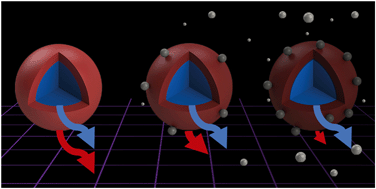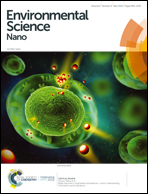Ratiometric detection of heavy metal ions using fluorescent carbon dots†
Abstract
Classical methods for the detection of heavy metal ions in water are tedious and time consuming. Thus, there exists a need to develop novel sensing technologies for more sensitive and rapid detection. While optical-based assays using fluorescent nanomaterials have been reported, they are typically dependent on changes to the signal intensity, which brings about several disadvantages for potential environmental monitoring. Moreover, most of these systems only demonstrate selectivity and sensitivity to one cation. Herein, we report the use of a novel dual absorbing/fluorescing carbon dot system and develop a ratiometric assay to detect heavy metal ions such as Co2+, Fe3+, Hg2+, and Pb2+. These carbon dots simultaneously absorb and fluoresce in both blue and red regions of the spectrum. Their optical absorbance signature differs depending on the metallic cation present in solution and the absorbance pattern also varies as a function of the metal cation concentration. This effect is also seen in fluorescence assays where selective quenching of the red fluorescence is observed. This quenching behavior is ascribed to the interaction of the metallic cations with the fluorescent surface states of the carbon dot. Using either absorbance or fluorescence quenching assays, a linear response in the nanomolar range (1–961 nM) is observed with detection limits of 96.8, 61.7, 39.5, 37.1 nM for Co2+, Fe3+, Hg2+, and Pb2+, respectively.

- This article is part of the themed collection: Best Papers 2019 – Environmental Science: Nano


 Please wait while we load your content...
Please wait while we load your content...